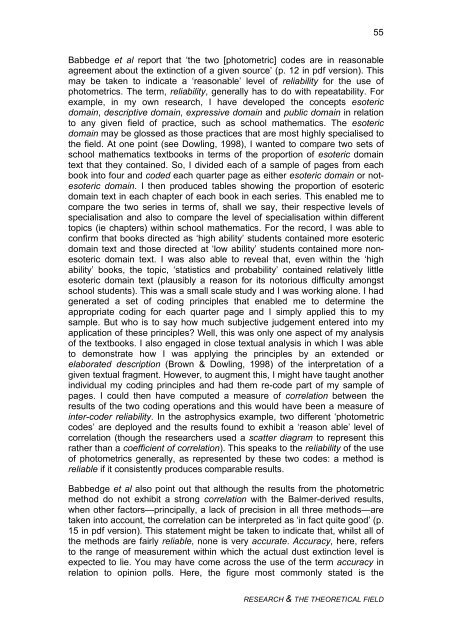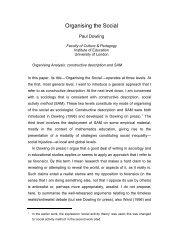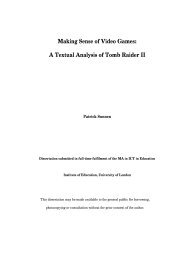Research and the Theoretical Field - Pauldowling.me
Research and the Theoretical Field - Pauldowling.me
Research and the Theoretical Field - Pauldowling.me
Create successful ePaper yourself
Turn your PDF publications into a flip-book with our unique Google optimized e-Paper software.
55<br />
Babbedge et al report that ‘<strong>the</strong> two [photo<strong>me</strong>tric] codes are in reasonable<br />
agree<strong>me</strong>nt about <strong>the</strong> extinction of a given source’ (p. 12 in pdf version). This<br />
may be taken to indicate a ‘reasonable’ level of reliability for <strong>the</strong> use of<br />
photo<strong>me</strong>trics. The term, reliability, generally has to do with repeatability. For<br />
example, in my own research, I have developed <strong>the</strong> concepts esoteric<br />
domain, descriptive domain, expressive domain <strong>and</strong> public domain in relation<br />
to any given field of practice, such as school ma<strong>the</strong>matics. The esoteric<br />
domain may be glossed as those practices that are most highly specialised to<br />
<strong>the</strong> field. At one point (see Dowling, 1998), I wanted to compare two sets of<br />
school ma<strong>the</strong>matics textbooks in terms of <strong>the</strong> proportion of esoteric domain<br />
text that <strong>the</strong>y contained. So, I divided each of a sample of pages from each<br />
book into four <strong>and</strong> coded each quarter page as ei<strong>the</strong>r esoteric domain or notesoteric<br />
domain. I <strong>the</strong>n produced tables showing <strong>the</strong> proportion of esoteric<br />
domain text in each chapter of each book in each series. This enabled <strong>me</strong> to<br />
compare <strong>the</strong> two series in terms of, shall we say, <strong>the</strong>ir respective levels of<br />
specialisation <strong>and</strong> also to compare <strong>the</strong> level of specialisation within different<br />
topics (ie chapters) within school ma<strong>the</strong>matics. For <strong>the</strong> record, I was able to<br />
confirm that books directed as ‘high ability’ students contained more esoteric<br />
domain text <strong>and</strong> those directed at ‘low ability’ students contained more nonesoteric<br />
domain text. I was also able to reveal that, even within <strong>the</strong> ‘high<br />
ability’ books, <strong>the</strong> topic, ‘statistics <strong>and</strong> probability’ contained relatively little<br />
esoteric domain text (plausibly a reason for its notorious difficulty amongst<br />
school students). This was a small scale study <strong>and</strong> I was working alone. I had<br />
generated a set of coding principles that enabled <strong>me</strong> to determine <strong>the</strong><br />
appropriate coding for each quarter page <strong>and</strong> I simply applied this to my<br />
sample. But who is to say how much subjective judge<strong>me</strong>nt entered into my<br />
application of <strong>the</strong>se principles Well, this was only one aspect of my analysis<br />
of <strong>the</strong> textbooks. I also engaged in close textual analysis in which I was able<br />
to demonstrate how I was applying <strong>the</strong> principles by an extended or<br />
elaborated description (Brown & Dowling, 1998) of <strong>the</strong> interpretation of a<br />
given textual frag<strong>me</strong>nt. However, to aug<strong>me</strong>nt this, I might have taught ano<strong>the</strong>r<br />
individual my coding principles <strong>and</strong> had <strong>the</strong>m re-code part of my sample of<br />
pages. I could <strong>the</strong>n have computed a <strong>me</strong>asure of correlation between <strong>the</strong><br />
results of <strong>the</strong> two coding operations <strong>and</strong> this would have been a <strong>me</strong>asure of<br />
inter-coder reliability. In <strong>the</strong> astrophysics example, two different ‘photo<strong>me</strong>tric<br />
codes’ are deployed <strong>and</strong> <strong>the</strong> results found to exhibit a ‘reason able’ level of<br />
correlation (though <strong>the</strong> researchers used a scatter diagram to represent this<br />
ra<strong>the</strong>r than a coefficient of correlation). This speaks to <strong>the</strong> reliability of <strong>the</strong> use<br />
of photo<strong>me</strong>trics generally, as represented by <strong>the</strong>se two codes: a <strong>me</strong>thod is<br />
reliable if it consistently produces comparable results.<br />
Babbedge et al also point out that although <strong>the</strong> results from <strong>the</strong> photo<strong>me</strong>tric<br />
<strong>me</strong>thod do not exhibit a strong correlation with <strong>the</strong> Bal<strong>me</strong>r-derived results,<br />
when o<strong>the</strong>r factors—principally, a lack of precision in all three <strong>me</strong>thods—are<br />
taken into account, <strong>the</strong> correlation can be interpreted as ‘in fact quite good’ (p.<br />
15 in pdf version). This state<strong>me</strong>nt might be taken to indicate that, whilst all of<br />
<strong>the</strong> <strong>me</strong>thods are fairly reliable, none is very accurate. Accuracy, here, refers<br />
to <strong>the</strong> range of <strong>me</strong>asure<strong>me</strong>nt within which <strong>the</strong> actual dust extinction level is<br />
expected to lie. You may have co<strong>me</strong> across <strong>the</strong> use of <strong>the</strong> term accuracy in<br />
relation to opinion polls. Here, <strong>the</strong> figure most commonly stated is <strong>the</strong><br />
RESEARCH & THE THEORETICAL FIELD




